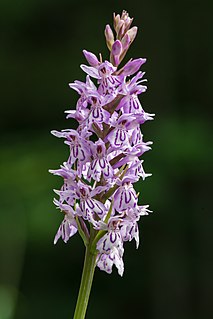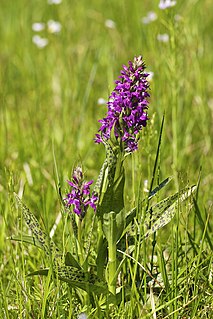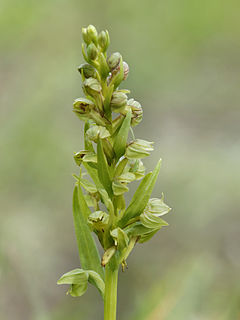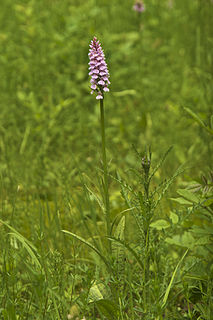
Anacamptis pyramidalis, the pyramidal orchid, is a perennial herbaceous plant belonging to the genus Anacamptis of the family Orchidaceae. The scientific name Anacamptis derives from Greek ανακάμτειν 'anakamptein' meaning 'bend forward', while the Latin name pyramidalis refers to the pyramidal form of the inflorescence.

Dactylorhiza fuchsii, the common spotted orchid, is a species of flowering plant in the orchid family Orchidaceae.

The genus Ophrys is a large group of orchids from the alliance Orchis in the subtribe Orchidinae. They are widespread across much of Europe, North Africa, the Canary Islands, and the Middle East as far east as Turkmenistan.

Anacamptis is a genus of flowering plants in the orchid family (Orchidaceae); it is often abbreviated as Ant in horticulture. This genus was established by Louis Claude Richard in 1817; the type species is the pyramidal orchid and it nowadays contains about one-third of the species placed in the "wastebin genus" Orchis before this was split up at the end of the 20th century, among them many that are of hybrid origin. The genus' scientific name is derived from the Greek word anakamptein, meaning "to bend backwards".

Dactylorhiza is a genus of flowering plants in the orchid family Orchidaceae. Its species are commonly called marsh orchids or spotted orchids,Dactylorhiza were previously classified under Orchis which has two round tubers.

Anacamptis morio, the green-winged orchid or green-veined orchid, is a flowering plant of the orchid family, Orchidaceae. It usually has purple flowers, and is found in Europe and the Middle East.

Dactylorhiza majalis, the broad-leaved marsh orchid, is a terrestrial Eurasian orchid.

Scheuchzeria palustris, is a flowering plant in the family Scheuchzeriaceae, in which there is only one species and Scheuchzeria is the only genus. In the APG II system it is placed in the order Alismatales of the monocots.

Coeloglossum is a genus of flowering plants in the orchid family Orchidaceae. It has long been considered to have only one species, Coeloglossum viride, the frog orchid. Some recent classifications regard Coeloglossum as part of the larger genus, Dactylorhiza, so that C. viride becomes Dactylorhiza viridis. Other sources continue to keep Coeloglossum viride separate.

Orchis mascula, the early-purple orchid, early spring orchis, is a species of flowering plant in the orchid family, Orchidaceae.

Neotinea ustulata is a European terrestrial orchid native to mountains in central and southern Europe, growing at up to 2,400 m (7,900 ft) elevation. The plant is considered Endangered in Great Britain and Least Concern internationally based on IUCN Red List criteria. The burnt-tip orchid was voted the county flower of Wiltshire in 2002 following a poll by the wild flora conservation charity Plantlife.

Ophrys sphegodes, commonly known as the early spider-orchid, is a species of sexually-deceptive orchid native to Europe and the Middle East. It is a very varied species with many subspecies recognised.

Dactylorhiza praetermissa, the southern marsh orchid or leopard marsh orchid, is a commonly occurring species of European orchid.

Dactylorhiza incarnata, the early marsh-orchid, is a perennial, temperate-climate species of orchid generally found growing in wet meadows, and generally on base-rich soils, up to about 2100m asl. The species occurs widely in Europe and Asia from Portugal and Ireland east to Siberia and Xinjiang.

Dactylorhiza lapponica, the Lapland marsh-orchid, is an orchid found in Scandinavia, Germany, Austria, Switzerland, France, Italy and the Czech Republic.

Dactylorhiza maculata, known as the heath spotted-orchid or moorland spotted orchid, is an herbaceous perennial plant of the family Orchidaceae. It is widespread in mountainous regions across much of Europe from Portugal and Iceland east to Russia. It is also found in Algeria, Morocco, and western Siberia.

Dactylorhiza purpurella, the northern marsh orchid, is an orchid native to Great Britain, Ireland and Denmark.

Dactylorhiza traunsteineri, the narrow-leaved marsh orchid or Traunsteiner's dactylorhiza, is a terrestrial species of orchid native to the cooler parts of the Eastern Hemisphere. It is native to Scandinavia, the Alps, and a region extending from Germany to Western Siberia. Although said by some sources to occur in Britain and Ireland, others say that plants identified as this species are actually Dactylorhiza majalis subsp. traunsteinerioides, a view supported by genetic data.

Dactylorhiza sambucina, the elder-flowered orchid, is an herbaceous plant belonging to the family Orchidaceae. It is quite common and widespread throughout much of Europe from Portugal east to Finland and Ukraine. The flowers appear in spring and summer, in various colors from yellow to purple.


















